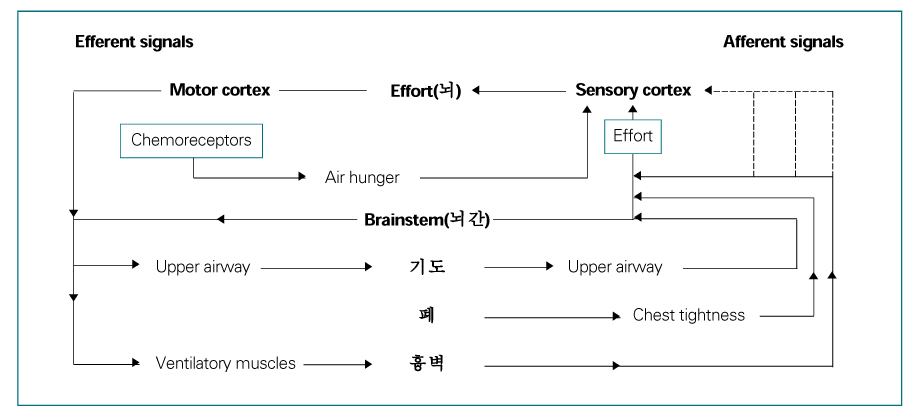J Korean Med Assoc.
2005 Mar;48(3):254-264. 10.5124/jkma.2005.48.3.254.
Dyspnea
- Affiliations
-
- 1Department of Respiratory Medicine, Ewha Womans University College of Medicine, Mokdong Hospital, Korea. hs1017@ewha.ac.kr
- KMID: 1723898
- DOI: http://doi.org/10.5124/jkma.2005.48.3.254
Abstract
- No abstract available.
Keyword
MeSH Terms
Figure
Reference
-
1. American Thoracic Society. Dyspnea. mechanisms, assessment, and management: a consensus statement. Am J Respir Crit Care Med. 1999. 159:321–324.2. Higgins M. Cassaburi R, Petty TL, editors. Epidemiology of obstructive pulmonary disease. Principles and practice of pulmonary rehabilitation. 1993. Philadelphia: WB Saunders.3. Moy ML, Woodrow WJ, Sparrow D, Israel E, Schwartzstein RM. Quality of dyspnea in bronchoconstriction differs from external resistive loads. Am J Respir Crit Care Med. 2000. 162:451–455.
Article4. Schwartzstein RM, Manning HL, Weiss JW, Weinberger SE. Dyspnea: a sensory experience. Lung. 1990. 168:185–199.
Article5. Hamilton AL, Killian KJ, Summers E, Jones NL. Muscle strength, symptom intensity and exercise capacity in patients with cardiorespiratory disorders. Am J Respir Crit Care Med. 1995. 152:2021–2031.
Article6. Fishman AP. Fishman AP, editor. Approach to the patient with respiratory symptoms. Fishman's pulmonary diseases and disorders. 1998. 3rd ed. New York: McGraw-Hill;366–370.7. Gifl AG, Cahill CA. Psychophysiologic aspects of dyspnea in chronic obstructive pulmonary disease: A pilot study. Heart Lung. 1990. 19:252–257.8. Maisel AS, Krishnaswamy P, Nowak RM, McCord J, Hollander JE, McCullough PA, et al. Rapid measurement of B-type natriuretic peptide in the emergency diagnosis of heart failure. N Engl J Med. 2002. 347:161–167.
Article9. Schwartzstein RM. Approach to the patient with dyspnea. 2004. 12(3). UpToDate;UpToDate.10. Killian KJ, Gandevia SC, Summers E, Campbell EJ. Effect of increased lung volume on perception of breathlessness, effort and tension. J Appl Physiol. 1984. 57:686–691.
Article11. O'Donnell DE, Bertley JC, Chau LK, Webb KA. Qualitative aspects of exertional breathlessness in chronic airflow limitation: pathophysiologic mechanisms. Am J Respir Crit Care Med. 1997. 155:109–115.12. Silvestri GA, Mahler D. Evaluation of dyspnea in the elderly patients. Clin Chest Med. 1993. 14:393–404.13. Simon PM, Schwartzstein RM, Weiss JW, Fencl V, Teghtsoonian M, Weinberger SE. Distinguishable types of dyspnea in patients with shortness of breath. Am Rev Respir Dis. 1990. 142:1009–1014.
Article14. Paul WJ. Gibson GJ, editor. Breathlessness. Respiratory Diseases. 2003. 3rd ed. China: Elsevier Science;285–290.15. Adams L, Chronos N, Lane R, Guz A. The measurement of breathlessness induced in normal subjects: validity of two scaling techniques. Clin Sci. 1985. 69:7–16.
Article16. Fletcher CM, Elmes PS, Fairbairn AS, Wood CH. The significance of respiratory symptoms and the diagnosis of chronic bronchitis in a working population. Br Med J. 1959. 5147:257–266.17. McGavin CR, Artvinli M, Naoe H, McHardy GJ. Dyspnea, disability and distance walked: comparison of estimates of exercise performance in respiratory disease. Br Med J. 1978. 2:241–243.
Article18. Mahler D, Rosiello R, Harver A, Lentine T, McGovern JF, Daubenspeck JA. Comparison of clinical dyspnea ratings and psychological measurements of respiratory sensation in obstructive airway disease. Am Rev Respir Dis. 1987. 135:1229–1233.
Article19. Casaburi R, Patessio A, Ioli F, Zanaboni S, Donner CF, Wasserman K. Reductions in exercise lactic acidosis and ventilation as a result of exercise training in patients with obstructive lung disease. Am Rev Respir Dis. 1991. 143:9–18.
Article20. Swinburn CR, Wakefield JM, Jones PW. Relationship between ventilation and breathlessness during exercise in chronic obstructive airway disease is not altered by prevention of hypoxemia. Clin Sci. 1984. 67:515–519.
Article21. Thomas RL, Stoker GL, Ross JC. Efficacy of pursed-lips breathing in patients with chronic obstructive pulmonary disease. Am Rev Respir Dis. 1966. 93:100–106.22. Swinburn CR, Mould H, Stone TN, Corris PA, Gibson GJ. Symptomatic benefit of supplemental oxygen in hypoxemic patients with chronic lung disease. Am Rev Respir Dis. 1991. 143:913–915.
Article23. Light RW, Muro JR, Sato RI, Stanburry DW, Fischer CE. Effects of oral morphine on breathlessness and exercise tolerance in patients with chronic obstructive pulmonary disease. Am Rev Respire Dis. 1989. 139:126–133.
Article24. Sibuya M, Yamada M, Kanamaur A, Tanaka K, Suzuki H, Homma I, et al. Effect of chest wall vibration on dyspnea in patients with chronic respiratory disease. Am J Respir Crit Care Med. 1994. 149:1235–1240.
Article25. Winning AJ, Hamilton RD, Shea SA, Knoff C, Guz A. The effect of airway anaesthesia on the control of breathing and the sensation of breathlessness in man. Clin Sci. 1985. 68:215–225.
Article26. Schwartzstein RM, Lahive K, Pope A, Weinberger SE, Weiss JW. Cold facial stimulation reduces breathlessness induced in normal subjects. Am Rev Respir Dis. 1987. 136:58–61.
Article27. Roussos C, Macklem PT. The respiratory muscles. N Engl J Med. 1982. 307:786–797.
Article28. Smoller JW, Pollack MH, Otto MW, Rosenbaum JF, Kradin RL. State of the art: panic anxiety, dyspnea and respiratory disease. Am J Respir Crit Care Med. 1996. 154:6–17.


